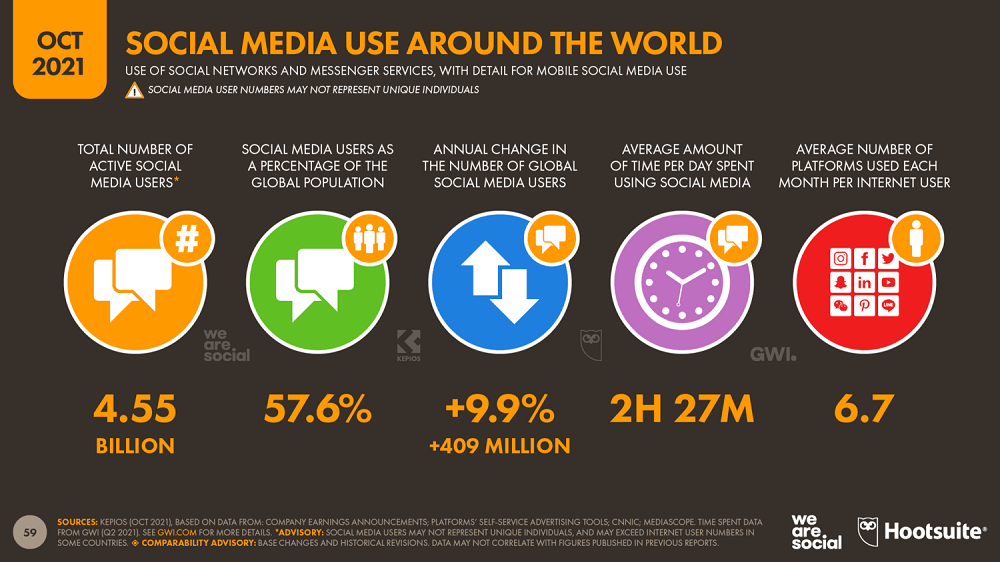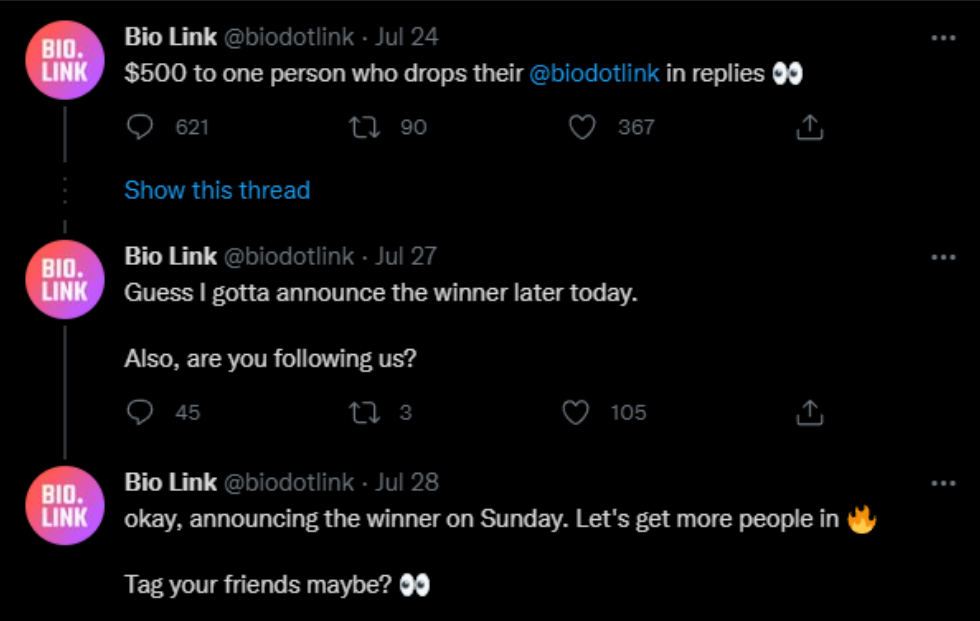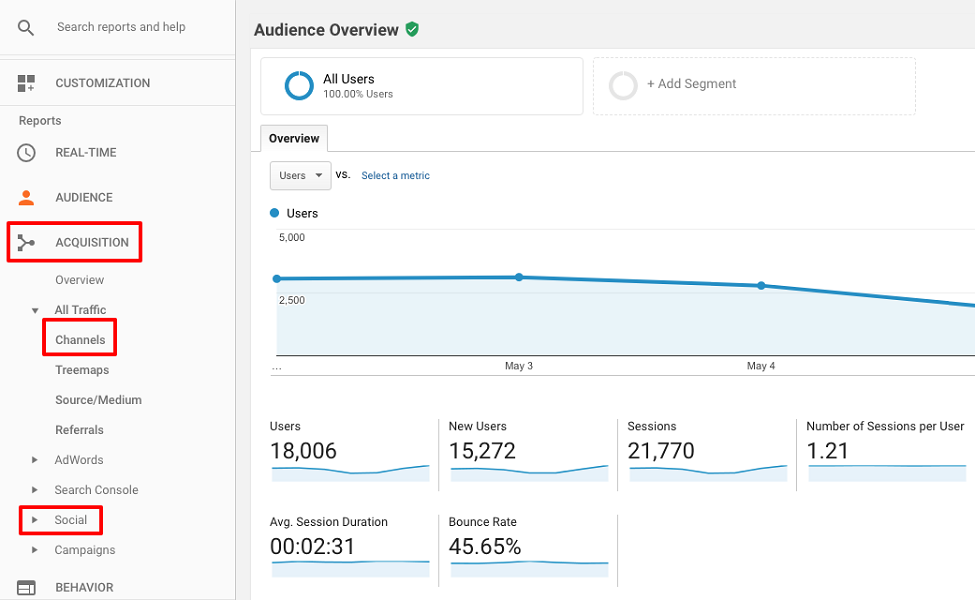Did you know that over 70% of marketers have seen positive results from social media marketing, including everything from more followers to more website traffic to more sales? With billions of users active on social media sites daily—your target audience included—there’s no disputing that social media marketing is a powerful tool.

However, to make it a valuable asset for your business, you can’t use it aimlessly. You need to set social media goals and, specifically, those that will contribute most to the overall success of your business. Kevin Berry of Marketing Stable put it nicely explaining:
“Each account will have different goals. For a brand needing brand awareness, reach is huge. For online commerce brands, a type of conversion will be more important than reach. If they provide customer service, engagement and customer experience is huge.”
So what should your social media goals be? To help you figure it out and be able to reach and measure your goals effectively, let’s consider some of the most common objectives, as well as how to reach and measure them.
The top 5 social media goals (and how to reach them)
Think about which of the following goals might be relevant for your company considering the strength of your current social media presence and, as already mentioned, your business’s goals and objectives.
Goal #1: Increase your reach
The “reach” of your company or brand refers to the percentage of your target audience that you reach through your marketing (including social media marketing). Why does it matter, though?
Generally, a relatively small percentage of the people who have the potential to become supporters and customers see your latest tweet, post, or marketing campaign. But by being more intentional about how, when, and where you market to those individuals, you can build more relationships that’ll lead to more sales down the road.
Ways to increase your reach on social media
To boost your reach on social media, you can:
- Start and join conversations. Encourage your audience and other brands to discuss industry-related topics (and even unrelated fun stuff occasionally). Get involved in social media groups and communities within your industry. Respond to comments, answer questions, and be helpful. People will notice.
- Run influencer marketing campaigns with influencers who have a similar audience to yours. If you pick the right partners, this can be a quick way to gain the trust of ideal customers, get leads, and make sales.
- Encourages your audience to create and share user-generated content. In addition to reminding people to retweet and share your content on the regular, you can also spark bursts of increased reach by running user-generated content campaigns.
Contests work well to get people engaged and spreading the word about you. For example, “Tag us in a video on [something related to your brand or industry], we’ll choose our 5 favorites, and winners will get [a desirable offer].”
Related: Learn more about Facebook contests and Instagram giveaways.
How to measure social media reach
The following metrics are useful for tracking your reach:
- Impressions. This is the number of times your content was visible on screen. You could think of it as the first stage of reach, which refers more to the number of people who actually saw or, even better, interacted with your posts.
- Engagement rate. What percentage of people who saw your latest post liked, commented on, or shared it? On average, how many people like, comment on share your post? The answer = your engagement rates. If they’re trending upward or holding steady at or above the average for your industry, that’s great!
- Brand mentions. It doesn’t matter whether you’re tagged or not, keep an eye out for discussions about your brand, notice whether they’re increasing or decreasing, and what the overwhelming sentiment is.
Most platforms including Instagram and Twitter allow you to view impressions, engagement rate, and other metrics for individual posts and your accounts in general. Plus, you can track brand mentions manually. However, this isn’t the most efficient way to go.
![]()
You’ll likely be better off with a tool like Hootsuite that aggregates all relevant data in one place.
(Get a deep-dive into the differences between impressions vs. clicks here.)
Goal #2: Gain new followers
You’ve probably heard it said that follower count is a “vanity metric,” an overrated number that has very little value. In some ways, that’s true.
However, just like an email list gives you ongoing access to your target market, when your ideal customers follow you on social media, they’re giving you ongoing access to their attention. They’re giving you additional opportunities to entertain and educate them, to make your company memorable, and to convert them into customers when the time is right.
Ways to gain social media followers
To grow your following, try the following:
- Entertain your audience. Humor, specifically, is an effective way to grab people’s attention and promote engagement, including follows. If you’re known for sharing entertaining content on social media, and if doing so is appropriate for your company type, you’ll almost certainly see an increase in followers.
- Educate your audience. Can you teach your ideal customer something that solves a problem or gets them closer to a goal of theirs? Yes; everyone has something they can teach! So posting informative content may be worth a try. If your audience responds well to it, you’ll gain their trust over time and, when they need a product or service like yours, you’ll be the go-to company.

An example of an Instagram post using humor to encourage engagement and generate more followers.
Resources to get more followers:
- How to get more followers on Twitter
- How to get TikTok followers
- How to get more Instagram followers
How to measure follower growth
There are three important aspects of this goal:
- Followers gained. And we’re not just talking about how many you gain. When did they follow you and does the answer correlate with the success of a certain social media post? If so, it can give you insights into what content types perform well. (Find out the best types of social media content to try here!)
- Quality of your followers. Additionally, what’s the quality of your following? Are they low-quality accounts doing follow for follow to try and increase their own visibility or are they your ideal followers and customers?
- Followers lost. Do many people who fit your ideal customer profile tend to follow you and then unfollow a short time later? Do you notice a bunch of unfollows after posting a certain type of content? Keep an eye out for patterns like these; they can tell you a lot about how your audience and their perception of you.
Probably the most straightforward social media metric to measure, you can use the built-in tools on most social media platforms (e.g. Twitter Analytics) to track fluctuations in your follower count. Or, if you prefer to view analytics from just one tool, you could use something like Buffer or Hootsuite.
Related: Find out how to do a social media audit to better analyze your social media marketing performance.
Goal #3: Increase audience engagement
Likes, comments, and shares on social media have a few benefits. For one thing, they help you understand what messaging and business decisions go over well with your audience and which ones don’t. For another, they can trigger the algorithms that social media platforms use to decide which posts to promote, resulting in increased visibility, more followers, etc.
Ways to increase audience engagement
You can generate more likes, comments, and shares on social media by:
- Choosing engaging topics. And using conversational language to encourage discussions.
- Being active and responsive on your company accounts. This can get people excited about the opportunity to interact with you directly and encourage them to engage.
- Tagging other brands or doing influencer marketing campaigns. That way, your content is cross-promoted by people and brands with credibility and the ability to expose you to a wider audience.
- Doing contests, giveaways, and user-generated content campaigns. For example, you could require followers to tag a few friends to enter a giveaway or tag you in a photo of themselves talking about how they use your product.

How to measure engagement
You’ll want to analyze:
- Likes, shares, and comments per post. You need to understand what content works best and what flops so that you can post more of the right things in the future.
- Brand mentions. Does your audience think you’re worth talking about? If so, and the conversations are positive, that’s a good sign.
- Your engagement rate. If you don’t know what percentage of your audience typically engages with your content, how can you improve that metric?
To find this info, you can check the built-in analytics features in whatever social media site you’re using or you can pull all of your data into a single dashboard using a social media management tool.
As you work to increase engagement, make sure you adhere to the community guidelines for each social site. Not doing so may result in your account being shadowbanned, which severely limits engagement. Learn more about what a shadow ban is here.
Related: Social media accessibility can also help drive engagement (+it’s just good for your business!). Find out how to do it right.
Goal #4: Drive more website traffic
According to Sprout Social, 91% of people visit the company website after following a brand on social media. So, if you’re looking for ways to generate more and higher-quality website traffic, social media may be the answer!
Ways to increase your website traffic with social media
You can drive more traffic to your website by:
- Doing interesting things. If people like what you’re doing, they’ll naturally be curious and check out your website. So, even if you’re not in the most interesting industry ever, find ways to stand out. For example, emphasize your unique value proposition and its benefits for your customers or clients.
- Using clear calls-to-action. Promoting your latest blog post? Doing a sale? Introducing a new service? If there’s a reason for your social media followers to visit your website, specifically invite them to do so. A simple prompt can often be more effective than waiting for them to take that next step on their own.

In this example, a small business owner is going live on LinkedIn to spark interest in his unique brand—which could drive traffic to his website later.
How to measure website traffic increases
Besides looking at the performance of individual posts via built-in analytics features, what else should you be looking at? In Google Analytics (or whatever analytics tool you use), take note of:
- How much traffic comes from social media. If not a lot, you can start thinking of tactics to drive more people to your website, including the ones above.
- Which social media sites drive the most traffic. You don’t want to waste your time or your budget so this will help you focus your attention where it gets the best results.
- The bounce rate of that traffic. Do visitors leave your site without interacting on the page they land on or without visiting other pages on your website? If so, you may be building a low-quality audience and/or failing to present a clear message.
And, in addition to bounce rate, track the other behavior of visitors who land on your site from social media. Ultimately, increasing your traffic isn’t a meaningful goal if site visitors don’t sign up for your email list, request a demo, buy a product, or otherwise convert.
Related: Try these social media marketing tools to help you reach your goals.
Goal #5: Generate quality leads
Generating leads is a crucial step that happens early in the marketing and sales funnels. It’s the start of the relationship between you and your ideal customers, which you can and should build upon to eventually earn their business.
Ways to get more leads
There are countless ways to generate leads using social media but a few of the most popular include:
- Running contests. If you require an email to enter, you can get your foot in the door and nurture interest in your brand through email marketing.
- Directing followers to your landing pages. Have a gated offer you’re promoting? Pop the link in your bio. And include it in your tweets or captions on platforms that allow clickable links (AKA not Instagram captions, folks).
- Lighting a fire under brand advocates. You could even start an official affiliate program with an emphasis on social media promotion. When your loyal fans mention you in their social circles, not only can it increase the number of leads you get but it can also increase the level of trust people have in your brand.
How to measure leads generated
Depending on the goals of your company, you may want to track:
- Email list signups. How many people from social media sign up for your email list? Do certain social media channels (or content types) result in higher signup rates than others? Track both to optimize results and generate more leads that you can nurture into customers down the line.
- Downloads. Do you have gated resources that require people to give contact information in exchange for access? Keep tabs on how many people follow through on giving their info and keep in touch with them.
- Sales. In addition to tracking smaller conversions such as email list signups, figure out whether the leads you get from social media eventually become customers. If not, you may need to change your social media strategy and/or the social media and overall marketing channels you use.

You can get much of this information in Google Analytics by going to Acquisition > Channels > Social.
Related: Find out how building a social media funnel can help you turn more followers into customers.
The only way to reach social media goals successfully
Identified some goals that are aligned with your long-term business goals? That’s great but there’s more work to do to make your social media marketing efforts successful.
For one thing, you need to get more specific about what social media success looks like for you. You need SMART goals; goals that are specific, measurable, attainable, relevant, and time-bound. So pick the metric you need to improve most, decide on a number that’s within your reach, and set a target date by which to reach that objective.
Then, you can get started, right? Not quite! On the importance of having analytics and tags set up correctly, Maria-Cristina Muntean, co-founder of Chillital said:
“Can’t stress this enough. You can have all the goals you want, but if you can’t track them properly, it’s all lost and you can’t prove ROI accurately.”
True, setting up analytics isn’t an exciting activity for most. And analytics tools can be confusing if you’re not familiar with them. But accurate data is essential for judging the impact of your efforts, optimizing them, managing your budget wisely, and moving your business forward. So, if you need to hire a social media pro to help with analytics and tags, do it.
You’ll have the greatest chance of reaching and exceeding your social media goals if you take the foundational steps of SMART goal-setting and proper analytics setup!
Here are the top social media goals to consider for your strategy:
- Increase your reach
- Gain new followers
- Improve audience engagement
- Drive more website traffic
- Generate quality leads
Related: Not setting goals tops our list of social media mistakes. Find out what else makes the list–and what to do instead!
Related Articles
-

60 Awesome August Social Media Holidays & Ideas (with Tips + Examples)
-

16 4th of July Social Media Posts to Make Your Brand Sparkle & Shine
-

70 June Social Media Holidays & Ideas to Make a Summer Splash
-

19 Happy Father's Day Post Ideas & Tips (+Free Templates!)
-

26 Copy & Paste AI Prompts for Social Media

